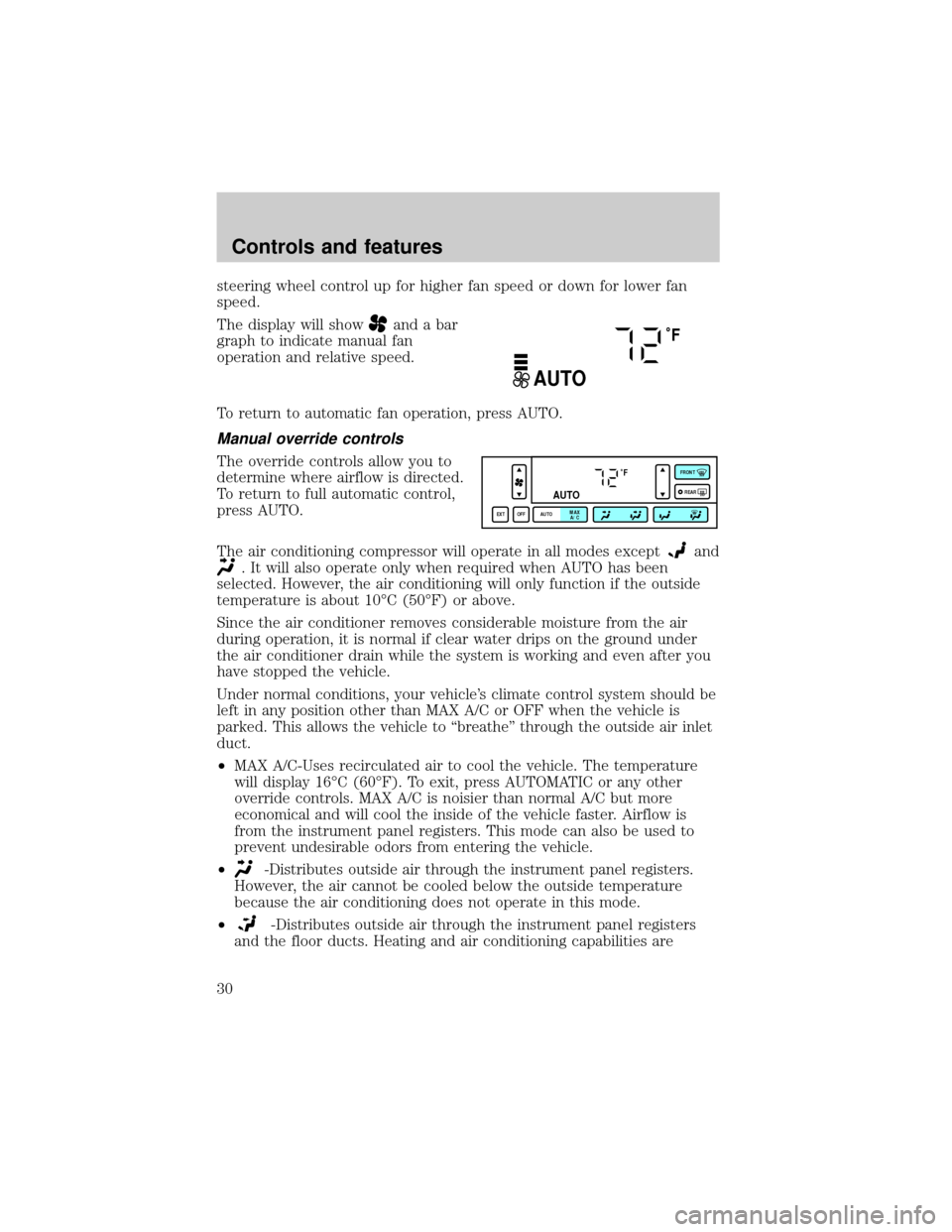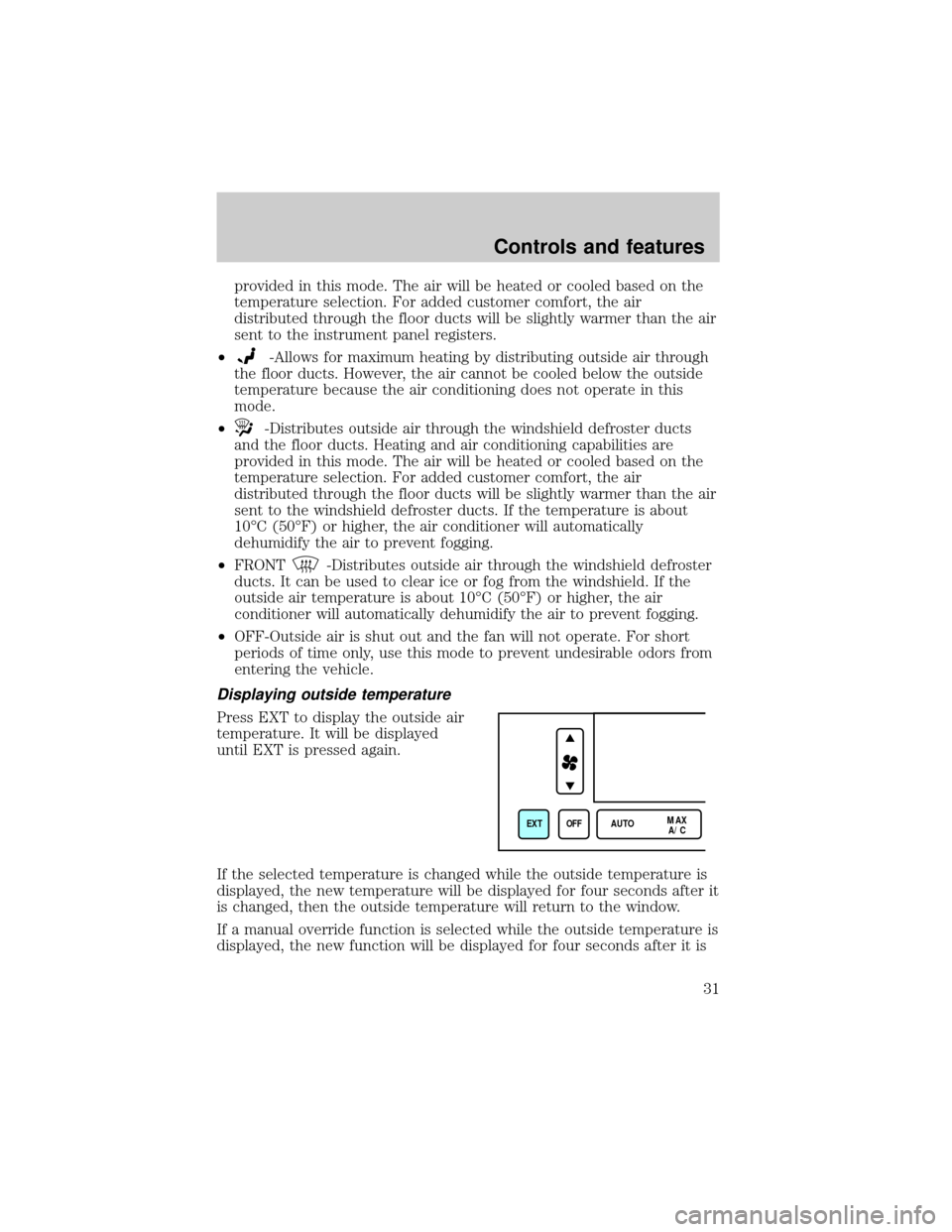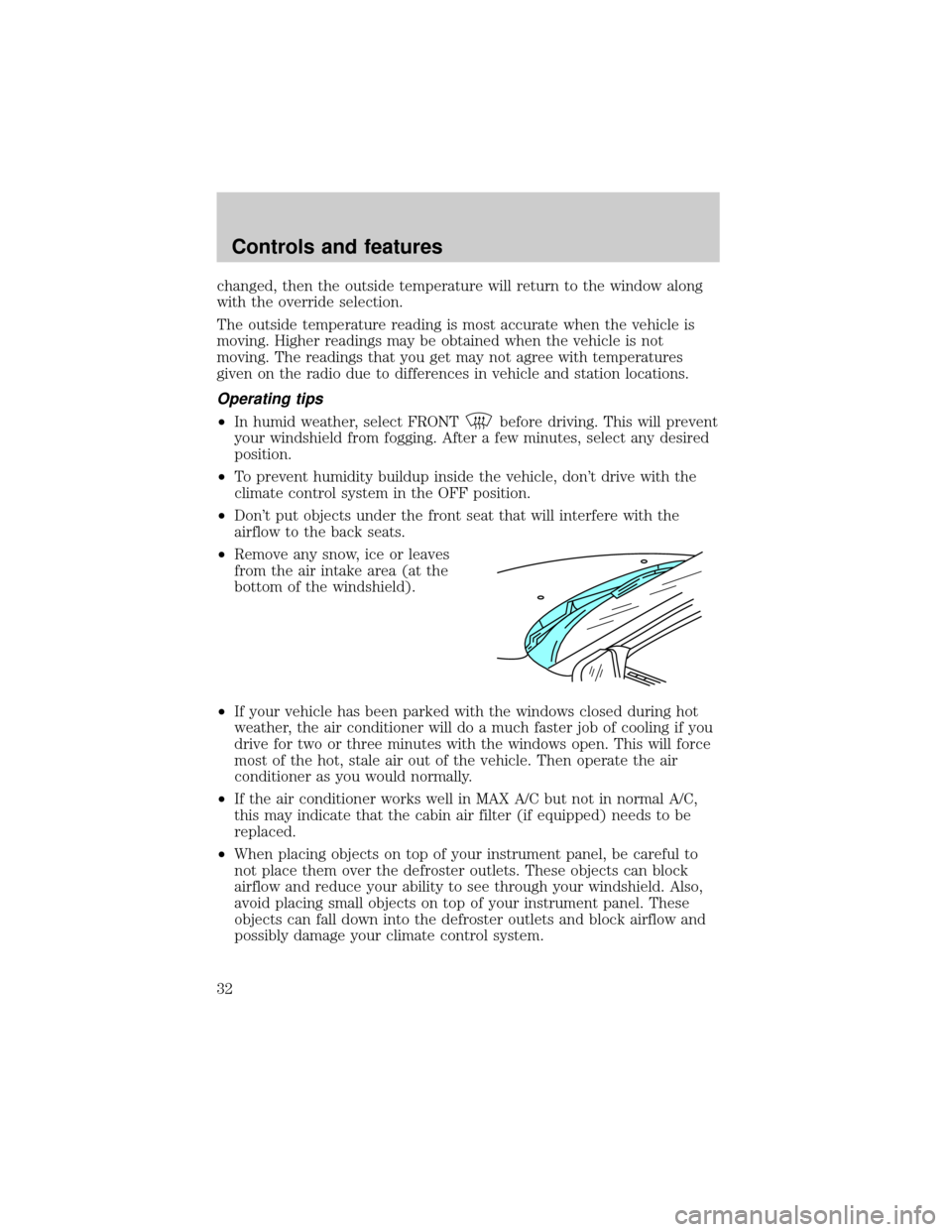1998 LINCOLN CONTINENTAL instrument panel
[x] Cancel search: instrument panelPage 4 of 176

RESUME
SET ACCEL
COAST
OFF
ON
80
MPH km/h
ABS
P!BRAKE
+ Ð
RPMx1000NORM
T/C
OFF
CHEF
FILL ON RIGHT
SERVICE
ENGINE
SOON AIR
BAG TURN ON
HEAD
LAMPS0 123456
7
0 2060
80
100
1200 204060100
120
140
160
180
200
40
OFFHI
LO
P0FFLIGHTS
AUTO
LAMP
SRS
Headlamp control
(pg. 26)
Turn signal and
wiper/washer control
(pg. 35)Instrument cluster
(pg. 6)
Driver air bag
(pg. 80) Speed control
(pg. 36) Instrument panel
dimmer switch
(pg. 27) Auto lamp
(pg. 27)
Instrumentation
4
Page 19 of 176

Autolamp on/delay time
Standard vehicle with Memory Profile System: setting may be saved to
either the Driver 1 or 2 personalized profiles or as a vehicle setting.
Instrument panel dim control setting
²Standard vehicle: setting is saved as vehicle setting only
(not the Driver 1 or 2 individualized profiles).
²Standard vehicle with Memory Profile System: setting may be saved to
either the Driver 1 or 2 personalized profiles or as a vehicle setting.
²Settings: variable.
²Original setting: maximum.
²Setting adjustment is made using the lighting control module-panel
dim control.
Driver's seat position
²Setting may be saved to either the Driver 1 or 2 personalized profiles
or as a vehicle setting.
²Settings: 8-way adjustment.
²Original setting: N/A.
²Setting adjustment is made using the driver seat control.
Outside mirror position
²Setting may be saved to either the Driver 1 or 2 personalized profiles
or as a vehicle setting.
²Settings: horizontal and vertical.
²Original setting: N/A.
²Setting adjustment is made using the outside mirror control.
DRIVER PROFILE SYSTEM (IF EQUIPPED)
The Driver profile System allows for two primary drivers to save their
individual seat and outside rearview mirror position preferences. The
feature will then be set to the individual's preferences when that
individual identifies themselves to the system before entering the vehicle.
The Message Center info allows the driver to program eight vehicle
features (listed in Driver Profile features) according to their driving
preferences. These feature preferences will be saved as the vehicle
Instrumentation
19
Page 23 of 176

²Standard vehicle with Memory Profile System-setting may be saved to
either the DRIVER MEMORY 1 or 2 personalized profiles or as a
vehicle setting.
²Settings-low, normal, high
²Original setting-normal
²Setting adjustment made using: Message Center-VEHICLE
HANDLING/SELECT controls
Autolamp on/delay time
²Standard vehicle with Memory Profile System-setting may be saved to
either the DRIVER MEMORY 1 or 2 personalized profiles or as a
vehicle setting.
Instrument panel dim control setting
²Standard vehicle-setting is saved as vehicle setting only
(not the DRIVER MEMORY 1 or 2 individualized profiles).
²Standard vehicle with Memory Profile System-setting may be saved to
either the DRIVER MEMORY 1 or 2 personalized profiles or as a
vehicle setting.
²Settings-variable
²Original setting-maxium
²Setting adjustment made using: Lighting Control Module-panel dim
control.
Driver's seat position
²Standard vehicle-setting may be saved to either the DRIVER MEMORY
1 or 2 personalized profiles or as a vehicle setting.
²Standard vehicle with Memory Profile System-setting may be saved to
either the DRIVER MEMORY 1 or 2 personalized profiles or as a
vehicle setting.
²Settings-8-way adjustment
²Original setting-N/A
²Setting adjustment made using: driver seat control
Outside mirror position
²Standard vehicle-setting may be saved to either the DRIVER MEMORY
1 or 2 personalized profiles or as a vehicle setting.
Instrumentation
23
Page 25 of 176

Memory Profile System (if equipped)
The Memory Profile System allows the two primary drivers to select and
save individualized preferences for the following eleven vehicle features:
²Express window
²Auto door locks
²Horn chirp
²Easy entry/exit seat access
²Reverse mirrors
²Adjustable ride
²Adjustable steering
²Autolamp on/delay time
²Instrument panel dim control
²Driver's seat position
²Outside mirror position
Basic Operation of the Driver Profile System with Memory Profile System
is the same, with the added option of being able to identify who is
driving the vehicle by using the Message Center controls. Refer to
ªMessage Centerº in theInstrumentationchapter for more information
on the Message Center controls. The Message Center has a Driver ID
control, which when pressed, allows the driver to select either Driver 1,
Driver 2 or OFF. Selecting OFF will turn the system OFF.
Instrumentation
25
Page 27 of 176

INSTRUMENT PANEL DIMMER CONTROL
Use to adjust the brightness of the instrument
panel during headlight and parklamp operation.
²Push up to brighten.
²Push down to dim.
AUTOLAMP CONTROL
The autolamp system provides light
sensitive automatic on-off control of
the exterior lights normally
controlled by the headlamp control.
The autolamp system also keeps the
lights on for a preselected period of
time after the ignition switch is
turned to OFF.
²To turn autolamps on, push the
control up toward the MAX position. As you press this switch, the
autolamp system's status will be displayed in the message center. The
system can be set to provide light for up to three minutes after you
turn the ignition OFF.
²To turn autolamps off, push the control down toward OFF.
CLIMATE CONTROL SYSTEM
Electronic Automatic Temperature Control (EATC) system
The EATC system will maintain a
selected temperature and
automatically control airflow. You
can override automatic operation
with any of the override controls,
the fan speed control or the steering
wheel controls (if equipped).
Turning the EATC on
Press AUTO, any of the override
controls or the fan speed control.
The EATC will only operate when
the ignition is in the ON position.
PANEL
DIM
MAX
OFF
AUTO
LAMP
˚F
AUTO
EXT OFF AUTOMAX
A/CFRONT
REAR
˚F
AUTO
EXT OFF AUTOMAX
A/CFRONT
REAR
Controls and features
27
Page 30 of 176

steering wheel control up for higher fan speed or down for lower fan
speed.
The display will show
and a bar
graph to indicate manual fan
operation and relative speed.
To return to automatic fan operation, press AUTO.
Manual override controls
The override controls allow you to
determine where airflow is directed.
To return to full automatic control,
press AUTO.
The air conditioning compressor will operate in all modes except
and
. It will also operate only when required when AUTO has been
selected. However, the air conditioning will only function if the outside
temperature is about 10ÉC (50ÉF) or above.
Since the air conditioner removes considerable moisture from the air
during operation, it is normal if clear water drips on the ground under
the air conditioner drain while the system is working and even after you
have stopped the vehicle.
Under normal conditions, your vehicle's climate control system should be
left in any position other than MAX A/C or OFF when the vehicle is
parked. This allows the vehicle to ªbreatheº through the outside air inlet
duct.
²MAX A/C-Uses recirculated air to cool the vehicle. The temperature
will display 16ÉC (60ÉF). To exit, press AUTOMATIC or any other
override controls. MAX A/C is noisier than normal A/C but more
economical and will cool the inside of the vehicle faster. Airflow is
from the instrument panel registers. This mode can also be used to
prevent undesirable odors from entering the vehicle.
²
-Distributes outside air through the instrument panel registers.
However, the air cannot be cooled below the outside temperature
because the air conditioning does not operate in this mode.
²
-Distributes outside air through the instrument panel registers
and the floor ducts. Heating and air conditioning capabilities are
˚F
AUTO
˚F
AUTO
EXT OFF AUTOMAX
A/CFRONT
REAR
Controls and features
30
Page 31 of 176

provided in this mode. The air will be heated or cooled based on the
temperature selection. For added customer comfort, the air
distributed through the floor ducts will be slightly warmer than the air
sent to the instrument panel registers.
²
-Allows for maximum heating by distributing outside air through
the floor ducts. However, the air cannot be cooled below the outside
temperature because the air conditioning does not operate in this
mode.
²
-Distributes outside air through the windshield defroster ducts
and the floor ducts. Heating and air conditioning capabilities are
provided in this mode. The air will be heated or cooled based on the
temperature selection. For added customer comfort, the air
distributed through the floor ducts will be slightly warmer than the air
sent to the windshield defroster ducts. If the temperature is about
10ÉC (50ÉF) or higher, the air conditioner will automatically
dehumidify the air to prevent fogging.
²FRONT
-Distributes outside air through the windshield defroster
ducts. It can be used to clear ice or fog from the windshield. If the
outside air temperature is about 10ÉC (50ÉF) or higher, the air
conditioner will automatically dehumidify the air to prevent fogging.
²OFF-Outside air is shut out and the fan will not operate. For short
periods of time only, use this mode to prevent undesirable odors from
entering the vehicle.
Displaying outside temperature
Press EXT to display the outside air
temperature. It will be displayed
until EXT is pressed again.
If the selected temperature is changed while the outside temperature is
displayed, the new temperature will be displayed for four seconds after it
is changed, then the outside temperature will return to the window.
If a manual override function is selected while the outside temperature is
displayed, the new function will be displayed for four seconds after it is
EXT OFF AUTOMAX
A/C
Controls and features
31
Page 32 of 176

changed, then the outside temperature will return to the window along
with the override selection.
The outside temperature reading is most accurate when the vehicle is
moving. Higher readings may be obtained when the vehicle is not
moving. The readings that you get may not agree with temperatures
given on the radio due to differences in vehicle and station locations.
Operating tips
²In humid weather, select FRONTbefore driving. This will prevent
your windshield from fogging. After a few minutes, select any desired
position.
²To prevent humidity buildup inside the vehicle, don't drive with the
climate control system in the OFF position.
²Don't put objects under the front seat that will interfere with the
airflow to the back seats.
²Remove any snow, ice or leaves
from the air intake area (at the
bottom of the windshield).
²If your vehicle has been parked with the windows closed during hot
weather, the air conditioner will do a much faster job of cooling if you
drive for two or three minutes with the windows open. This will force
most of the hot, stale air out of the vehicle. Then operate the air
conditioner as you would normally.
²If the air conditioner works well in MAX A/C but not in normal A/C,
this may indicate that the cabin air filter (if equipped) needs to be
replaced.
²When placing objects on top of your instrument panel, be careful to
not place them over the defroster outlets. These objects can block
airflow and reduce your ability to see through your windshield. Also,
avoid placing small objects on top of your instrument panel. These
objects can fall down into the defroster outlets and block airflow and
possibly damage your climate control system.
Controls and features
32